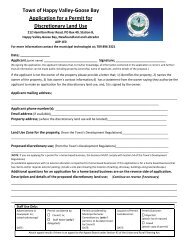Newcomers Guide2.1 - Happy Valley-Goose Bay
Newcomers Guide2.1 - Happy Valley-Goose Bay
Newcomers Guide2.1 - Happy Valley-Goose Bay
You also want an ePaper? Increase the reach of your titles
YUMPU automatically turns print PDFs into web optimized ePapers that Google loves.
Look for signs of fluids leaking from the car, including oil, brake or transmission fluid;<br />
• Over-sprayed or new paint, which might indicate the car has been repaired after an accident;<br />
• Shock absorbers by pushing down on the corners of the car. If the car bounces up and down several<br />
times, the shocks are worn;<br />
• Signs of an accident, such as dents or new paint or chrome. Make sure the hood closes properly. Check<br />
the body for rust or fill;<br />
• Signs of fluid leaks on the ground around the car;<br />
• The condition of the tires;<br />
• The trunk. Check for a jack and the condition of the spare tire. Check for rust under the mats. Look at<br />
the tires closely for any signs of uneven wear.<br />
The Inside<br />
• Battery to see if it is cracked;<br />
• Dimmer switch, headlights and windshield washer;<br />
• Dipstick to see the oil level and whether it is dirty;<br />
• Doors open and close easily, and the handles and locks work well;<br />
• The 17-digit Serial (VIN) numbers on the dashboard and doors should match (otherwise the car could be<br />
stolen);<br />
• Engine to check the condition of the belts and hoses;<br />
• Fluid levels of the radiator, windshield wiper, oil, brakes and transmission;<br />
• Odometer. It is against the law to change the odometer;<br />
• Parts and accessories, such as lights, horn, mirrors, seatbelts, radio, heater, and windows. Make sure<br />
they all work. Have a friend check the outside lights for you;<br />
• Signs of flooding, such as water lines on the engine, new carpeting or upholstery, rusting under the seats<br />
Asking the seller a few basic questions can you give you a lot of information:<br />
• Are there any needed repairs that you are aware of?<br />
• Has the car been in any accidents?<br />
• Has the car ever been flooded or declared a loss by an insurance company?<br />
• How many kilometres are on it?<br />
• How many people have owned the car?<br />
• What type of gas have they used?<br />
• Where has the car been driven most- in the city or on the highway?<br />
• Why are you selling he car?<br />
• If you are buying a car from a dealer, who was the last owner?<br />
If possible, test-drive the car on different types of roads. Make sure the engine starts right away and there are<br />
no unusual noises or vibrations. Be alert to shaky steering. Test the brakes for signs of pulling. A brake<br />
pedal that looks worn out should not be found in a car with low mileage. If the car has a manual<br />
transmission, push the clutch through various gears to see how it performs.<br />
Always check the serial (VIN), plate and registration sticker numbers on the Vehicle Registration card.<br />
Make sure they are the same as on the car. Make sure the person who is selling the car actually owns it, and is<br />
not trying to sell a leased or someone’s else’s vehicle.<br />
Ask the seller to show you the maintenance records, which can tell you how carefully and frequently the<br />
previous owners did routine maintenance such as oil changes. Maintenance records can often reveal accident<br />
repairs and mechanical problems. It is important to have an independent mechanic inspect the vehicle for<br />
defects before buying it. Be sure to get a written inspection report from the mechanic, with a cost estimate for<br />
any necessary repairs.<br />
If you decide to buy, you can make an offer in writing, or verbally. If there are conditions to your offer write<br />
32






